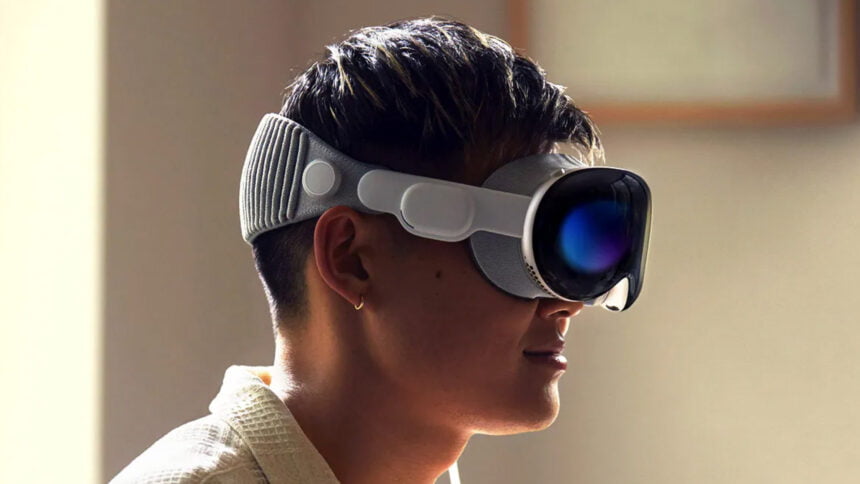In a world where the boundaries between reality and the virtual world are becoming increasingly blurred, the technology industry is on the brink of a new era in virtual and augmented reality: the recently launched Apple Vision Pro is revolutionising the way we interact with digital environments. With this in mind, we spoke to Dennis Briddigkeit, CEO of Hamburg-based virtual reality games studio Curvature Games. beyourpilot and Startup Port played a key role in the start-up’s development.
How does the Apple Vision Pro (AVP) improve the user experience compared to existing virtual reality and augmented reality solutions? Which specific technological breakthroughs of it do you find most impressive, and why?

I haven’t had the AVP in my hands yet, as it’s only available in the USA so far. But from what you see in reviews and reports, it seems to set a new standard in augmented reality (AR for short – that’s the computerised extension of reality perception). Although this word should no longer be used: Apple is trying hard to establish the term ‘spatial computing’, the words virtual reality (VR for short – which is computer-generated reality) and AR do not appear in its communications. However, ‘spatial computing’ is nothing new or something that Apple has invented. It is a concept that describes how people interact spatially with computers instead of just sitting in front of a screen.
In total, the device has around 5,000 patents, so there are some firsts. However, the biggest breakthrough is probably the attention that ‘spatial computing’ is receiving. Then there are two things that Apple can really do: Hardware and User Experience Design (UX). Apple will help define the standard for headsets – maybe not with the V1 or the V2, but in the long run they will have a strong influence on general hardware development. The same goes for the UX. Apple has always been very good at making processes and interfaces simple and intuitive. As with the hardware, Apple will also set new standards in this area, which is extremely important in Extended Reality (XR): How do I as a human interact with my environment in a virtual spatial world?
What new possibilities does the Apple Vision Pro open up for game developers and content creators in the field of augmented reality?
The new sensors and cameras should be very powerful and enable precise tracking of movements and gestures, which in turn opens up new control and interaction possibilities. And that in turn allows us as developers to find new ways to let users interact with digital content in our applications.
How does the Apple Vision Pro fit into your vision of the future of spatial computing technology and immersive entertainment?
It was an open secret for a long time that Apple was working on a device. But it’s a good sign for the whole industry that the world’s most valuable brand is so clearly committed to XR and is investing in it. However, it was foreseeable that other major technology brands would enter this market in the long term. And at the end of the day, competition stimulates business. Hopefully, we as developers will benefit from this through new features to create content and tell stories and, at the end of the day, consumers will benefit from high-quality and hopefully affordable hardware.
How do you see the Apple Vision Pro in the context of the evolution of VR and AR technology, and what impact could it have on the future of immersive storytelling?
In my opinion, there are no new groundbreaking influences on the development of storytelling. At least nothing that doesn’t already exist. Other devices may not come close to the quality of the 3,500 US dollar (= 3,236 euros) device, but offer more in terms of functionality. But as I said, I’ll have to test and develop them myself first.
What long-term impact could the Apple Vision Pro have on the way we learn, work and play?
We are seeing more and more enquiries from the education, training and edutainment sectors. We are currently developing an exciting project that is specially designed for students. They work in a virtual microbiology lab and learn how such a lab works – an experience that is not accessible to every student in real life. This is particularly interesting for those who are considering a career in this field but have little to no opportunity to get a taste of it. You can recreate every conceivable scenario and, best of all, you can’t break anything. Perfect for learning. I can already imagine applications for every subject: Chemistry, physics, maths, history etc. The trick will probably just be to incorporate this technology into the curriculum in the long term. There are certainly still a lot of bureaucratic and unfortunately also financial barriers. But the first steps have been taken and we find this area super exciting.
… and how is Curvature Games preparing to be part of this change?
We are preparing as best we can. The investment of the world’s most valuable brand in spatial computing and XR is a good sign for the entire industry. Competition stimulates business and Meta has now been forced into action with the consumer brand Quest, even if they don’t want to admit it. However, these devices are actually difficult to compare: the AVP is clearly aimed at professionals and B2B, whereas the Quest wants to conquer the living room. But we’re keeping a close eye on what’s happening and naturally want to quickly let off steam creatively and technically on the brand new headsets.
To what extent does the Apple Vision Pro change Curvature Games’ approach to content creation and development?
We started out as a pure VR games studio, but that has changed somewhat over the last few years. There will probably always be a market for pure VR, but we now see ourselves as an XR creative and development studio – still focussing on games, of course, because we all come from a gaming background and don’t want to leave it. For example, we are currently developing a mixed reality game that combines virtual reality and augmented reality elements. And above all, we can see how other applications (e.g. education) can benefit from games and game design. The AVP as a spatial computing device reinforces our decision to open up in the field of XR – it is therefore a logical next step for us.
Does Curvature Games see potential collaborations or partnerships in connection with the Apple Vision Pro?
Yes, definitely. We already have customer enquiries, which we unfortunately have to put on hold due to the limited or complicated availability of the hardware. You also need an American iTunes account. However, we are preparing for this and already have some projects that we would like to port to the AVP.
What challenges might developers face when designing experiences for the Apple Vision Pro, and how does Curvature Games plan to overcome them?
Apple has its own programming language, but that’s really all there is to it. So you have to be familiar with developing for Apple products. But all in all, it’s not a big obstacle: you have to prepare yourself in terms of personnel and make sure that you have the necessary skills and experience in-house. In addition, each headset has its own characteristics and special features when it comes to development. However, as we have been developing for different headsets from the outset, this is nothing new for us and of course offers a welcome change with new features and possibilities. But to find out the exact answer, you finally have to hold the device in your own hands.
How has Curvature Games been positioned since the InnoRampUp funding decision and how are you preparing for the future?
InnoRampUp was an important component and help in the development of our company. In addition to developing games, the project business has also become increasingly important for us. In other words, contract work in the field of VR and AR. We develop a lot in the field of edutainment and education and have a few projects in the field of art and culture. As we work in a very fast-moving industry and the games industry in particular is not easy at the moment, we just have to remain agile and keep our eyes open as we go through the world. Something like the launch of AVP is a signal to the market and, as a small company, you simply have to keep an eye on where the market is heading and how you have to react to it. This is the question I get up with in the morning and the question I go to bed with in the evening. But that’s what makes it exciting.
Related links:

